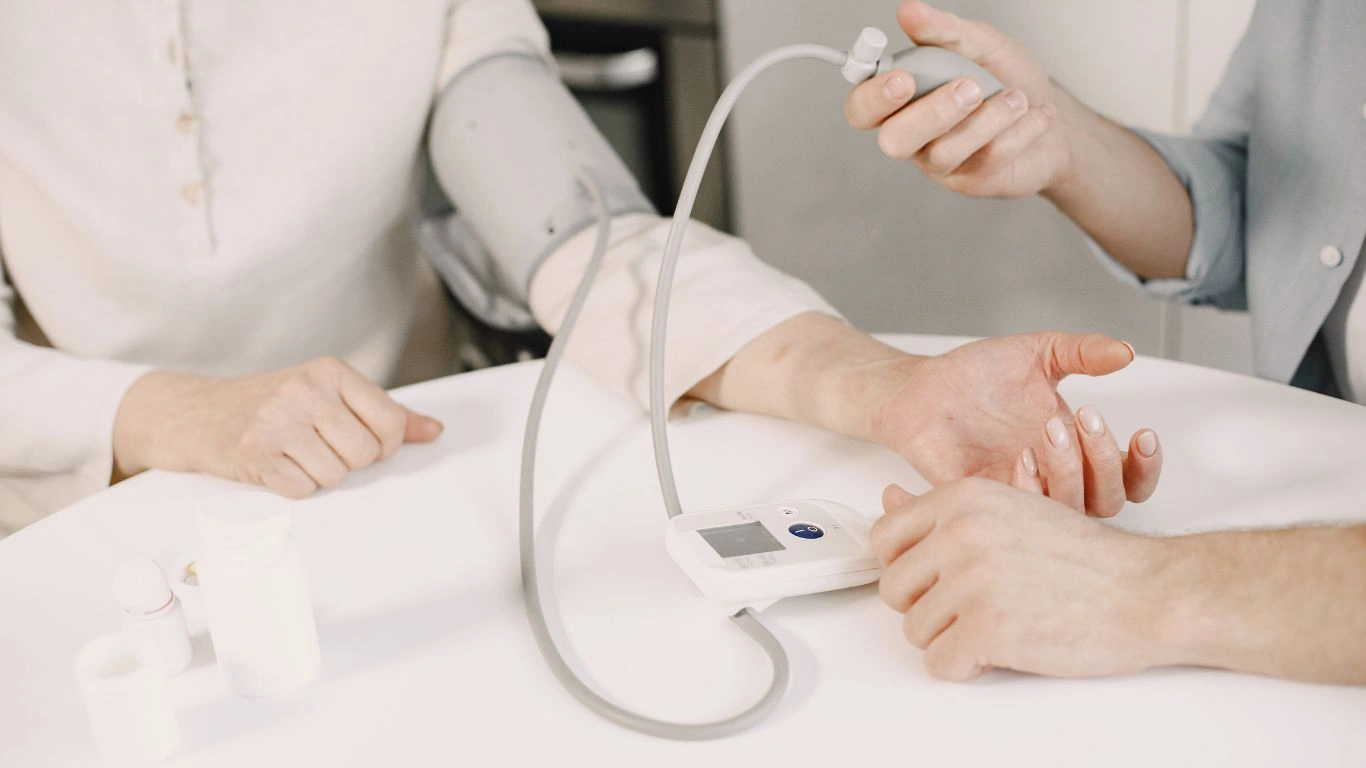Discover the Best Spices That Help Manage Hypertension Naturally for Better Health
As a physician specializing in hypertension management, I’ve had the privilege of helping countless patients manage their blood pressure through lifestyle changes, medication, and natural remedies. One of the most exciting aspects of hypertension management is exploring how certain foods, particularly spices, can play a significant role in controlling high blood pressure. Among the many options available, there are some standout spices that have shown promise in promoting heart health. In this article, we’ll dive into the best spices that help manage hypertension and how they can become part of your daily routine. Let’s take a closer look at how these kitchen staples can potentially benefit your health and help you maintain a healthier blood pressure.
Understanding Hypertension and Its Impact on Your Health

Hypertension, commonly known as high blood pressure, is a serious condition that affects millions of people worldwide. If left uncontrolled, it can lead to significant health problems, including heart disease, kidney failure, and stroke. Managing hypertension is crucial to maintaining overall health, and while medication plays a large role in treatment, diet is equally important. That’s where spices come in. Certain spices are known to have a direct positive effect on blood pressure, helping to lower it naturally. These spices are packed with antioxidants, anti-inflammatory properties, and other beneficial compounds that support cardiovascular health.
How Spices Can Help Manage Hypertension
Incorporating the best spices that help manage hypertension into your diet can be a simple yet effective strategy to complement other treatments. Spices don’t just add flavor to your food; they can also provide potent health benefits. Many of them are packed with essential nutrients that help reduce inflammation, improve blood circulation, and support heart health, all of which are critical for controlling blood pressure. Let’s dive into some of the most effective spices that you can add to your meals.
The Best Spices That Help Manage Hypertension

1. Garlic: Nature’s Powerhouse
Garlic is undoubtedly one of the most well-known natural remedies for a variety of health issues, including hypertension. Research has shown that garlic has a remarkable ability to lower blood pressure. The active compounds in garlic, particularly allicin, are thought to relax blood vessels and improve blood flow, which can help reduce blood pressure levels. I’ve seen this work wonders in many of my patients, especially when they incorporate garlic into their diet consistently. Not only is garlic delicious, but it also has the added benefit of supporting immune function and offering anti-inflammatory properties.
2. Cinnamon: A Heart-Healthy Spice
Cinnamon isn’t just for your morning coffee or baked goods – it can also help manage hypertension. Studies have shown that cinnamon can help reduce both systolic and diastolic blood pressure. This is likely due to its ability to improve blood vessel function and increase nitric oxide production, which helps relax blood vessels and lower blood pressure. A teaspoon of ground cinnamon added to your daily routine – whether in smoothies, oatmeal, or even sprinkled on fruit – can offer notable health benefits over time. Personally, I recommend adding it to your morning routine to get a steady dose of this heart-healthy spice.
3. Turmeric: A Golden Spice for Blood Pressure
Turmeric is another spice that has been studied extensively for its health benefits, particularly in reducing inflammation. The active compound curcumin found in turmeric has been shown to improve endothelial function, which plays a crucial role in regulating blood pressure. Curcumin also helps to combat oxidative stress, which can contribute to high blood pressure. I encourage many of my patients to add turmeric to their diet, whether in curries, teas, or even smoothies. It’s a simple way to boost your health and manage your blood pressure naturally.
Spices and Their Role in a Hypertension-Friendly Diet

When it comes to managing hypertension, diet is key. In fact, incorporating the best spices that help manage hypertension into your daily meals can be a game-changer. Not only do they provide health benefits, but they also make your food more exciting. By experimenting with various spices, you can find ways to reduce sodium intake (which is known to contribute to high blood pressure) and make your meals more flavorful without resorting to excessive salt. Additionally, many of these spices have a wealth of other health benefits, such as supporting your immune system, reducing inflammation, and improving circulation.
4. Ginger: A Zesty Addition to Your Meals
Ginger is another spice that’s been shown to have a positive impact on hypertension. It works by improving blood circulation, reducing inflammation, and promoting healthy blood flow. Studies suggest that ginger can help lower both systolic and diastolic blood pressure. Whether you add fresh ginger to your meals, brew it into tea, or use ginger powder in smoothies, it’s an easy and delicious way to support healthy blood pressure levels. As a bonus, ginger also has anti-nausea and digestive benefits!
5. Cayenne Pepper: A Spicy Way to Improve Circulation
Cayenne pepper, with its active compound capsaicin, is another excellent spice that can help manage hypertension. Capsaicin is known to improve blood flow by stimulating the release of nitric oxide, which relaxes blood vessels and lowers blood pressure. Although it might not be for everyone due to its heat, incorporating small amounts of cayenne pepper into your meals can provide a noticeable boost to your circulation and help reduce hypertension over time. Plus, it’s a great addition to spicy soups, stir-fries, and even certain beverages like a spicy lemon drink!
6. Cardamom: A Flavorful Antioxidant
Cardamom, a fragrant spice often used in Indian and Middle Eastern cuisine, has also been linked to lower blood pressure. Studies have shown that cardamom can reduce both systolic and diastolic blood pressure levels, likely due to its high antioxidant content and ability to improve circulation. It’s a fantastic addition to teas, rice dishes, and even baked goods. If you’ve never used cardamom before, I highly recommend giving it a try – not only for its health benefits but also for its delightful aroma and taste.
Incorporating Spices Into Your Daily Diet

Now that we’ve explored some of the best spices that help manage hypertension, it’s time to discuss how you can incorporate them into your daily meals. One of the things I love most about these spices is that they’re so versatile – whether you’re cooking, baking, or even making a cup of tea, there are countless ways to add them to your diet. And trust me, it doesn’t have to be complicated. I often recommend starting with a few key spices and gradually incorporating them into your meals. This way, it doesn’t feel like a chore, and you get used to their flavors and benefits. Here are some simple ways to add these hypertension-friendly spices to your diet:
1. Start Your Day with a Spiced Smoothie
If you’re looking for a quick and easy way to incorporate several of the best spices that help manage hypertension, smoothies are a great option. You can easily add turmeric, cinnamon, ginger, and even a pinch of cayenne pepper to your favorite smoothie recipe. I personally love starting my day with a turmeric and ginger smoothie – it’s both refreshing and packed with anti-inflammatory properties. Just toss in some spinach, almond milk, a banana, and a teaspoon of turmeric and ginger, and you’ve got yourself a powerhouse of flavor and health benefits.
2. Spice Up Your Soups and Stews
Soups and stews are another excellent way to add these spices to your diet. Whether it’s a hearty vegetable soup or a warming chicken stew, a pinch of cinnamon, turmeric, or garlic can make all the difference. For example, turmeric can give your soup a rich golden color while providing a burst of antioxidants that support heart health. I recommend adding these spices early in the cooking process so they have time to infuse the broth with their beneficial compounds.
3. Flavor Your Vegetables with Spices
Vegetables are a staple in any heart-healthy diet, and the good news is that they can be easily seasoned with the best spices for hypertension. Roasting vegetables like sweet potatoes, carrots, and cauliflower with a sprinkle of cinnamon or turmeric can elevate the flavor while also providing health benefits. I love to toss my veggies with a little olive oil, garlic, and cinnamon, then roast them in the oven until they’re perfectly caramelized. It’s a simple, flavorful way to get more of these heart-healthy spices into your diet.
The Importance of Consistency in Managing Hypertension

As we all know, managing hypertension requires consistency. It’s not just about making changes to your diet for a week or two – it’s about making long-term adjustments that support your heart health. Spices like garlic, cinnamon, and turmeric can have a positive impact on blood pressure, but only if they’re incorporated consistently into your diet. While they won’t replace medications prescribed by your doctor, they can work alongside your treatment plan to help support better blood pressure control.
In my practice, I often remind patients that lifestyle changes, including dietary adjustments, take time. It’s easy to get frustrated if you don’t see immediate results, but with regular use, the benefits of these spices start to add up. For example, adding garlic to your meals consistently can help lower blood pressure over time, as it works to improve blood vessel function and reduce inflammation. The same goes for cinnamon, which can help improve your vascular health when consumed regularly. So, don’t get discouraged if you don’t see results overnight – keep using these spices, and over time, you may notice significant improvements in your blood pressure.
4. Try Turmeric Lattes or Teas
If you’re not a fan of smoothies or soups, another great way to enjoy the benefits of turmeric is through turmeric lattes or teas. These drinks are becoming increasingly popular, and for good reason. Turmeric lattes, often called “golden milk,” are made with warm milk (or a non-dairy alternative) and turmeric, sometimes with a touch of black pepper to enhance absorption. This is a comforting, soothing drink that’s perfect for the evening or even as a mid-afternoon pick-me-up. I personally find it incredibly relaxing and a great way to wind down while reaping the benefits of this anti-inflammatory spice.
5. Spice Blends for Everyday Cooking
If you’re someone who loves convenience, spice blends are an excellent way to make sure you’re using a variety of the best spices that help manage hypertension. There are plenty of pre-made spice blends available that contain turmeric, cinnamon, garlic powder, and other heart-healthy ingredients. I often recommend keeping a few of these blends in your kitchen for easy access. You can sprinkle them over roasted vegetables, mix them into rice dishes, or even use them in marinades for chicken or tofu. These blends are a fantastic way to simplify the process while still getting the health benefits.
Pairing Spices with Other Blood Pressure-Lowering Foods

While spices alone are powerful, they’re even more effective when paired with other foods that help lower blood pressure. For example, combining garlic with heart-healthy olive oil and leafy greens, or adding cinnamon to a bowl of oatmeal with some berries, is a great way to create a balanced meal that supports your overall health. If you’ve been following the DASH (Dietary Approaches to Stop Hypertension) diet, you’ll be familiar with the types of foods that help lower blood pressure – and incorporating the best spices for hypertension into those meals will only enhance their effectiveness.
Leafy greens like spinach and kale, rich in potassium, work in harmony with the blood pressure-lowering properties of garlic and turmeric. Pairing these with high-fiber foods like oats, quinoa, and legumes will further support your cardiovascular health and help maintain a healthy weight. When planning meals, think about how you can combine the power of these spices with other heart-healthy ingredients for a well-rounded approach to hypertension management.
As you start to experiment with these spices and make them a regular part of your diet, remember that the key to managing hypertension effectively is consistency. The more you incorporate these spices into your daily routine, the better equipped you’ll be to support healthy blood pressure levels and improve your overall health.
The Role of Lifestyle Changes in Managing Hypertension

When it comes to managing hypertension, diet is only one piece of the puzzle. While incorporating the best spices that help manage hypertension is an excellent strategy, it’s essential to recognize that lifestyle changes are just as crucial. From exercise to stress management, the way we live our lives directly impacts our heart health. As a physician who works closely with patients to manage their blood pressure, I always emphasize that lifestyle changes go hand in hand with dietary adjustments.
Exercise: A Natural Blood Pressure Lowering Strategy
One of the most powerful ways to manage hypertension is regular physical activity. Exercise helps strengthen the heart, improve circulation, and lower blood pressure over time. Whether it’s going for a brisk walk, cycling, or participating in activities like yoga or swimming, moving your body regularly can have a profound impact on your health. I often tell my patients that exercise doesn’t have to mean hitting the gym for hours every day – just 30 minutes of moderate activity most days of the week can make a big difference. Consistency is key!
For those who may be new to exercise, I recommend starting slow and gradually building up stamina. Something as simple as a daily walk can be a great starting point, and as fitness levels improve, more strenuous activities can be incorporated. As you start to include exercise into your daily routine, don’t forget to pair it with those beneficial spices we’ve discussed, such as turmeric and garlic, to get the full cardiovascular benefits.
Managing Stress for Better Blood Pressure
Stress is another major contributor to high blood pressure. In fact, chronic stress is known to elevate blood pressure levels over time. This is why it’s crucial to find ways to relax and unwind. Simple activities such as deep breathing exercises, meditation, and mindfulness can go a long way in reducing stress and improving overall well-being. One thing I often encourage my patients to do is take short breaks throughout the day to relax, especially if their job or daily responsibilities tend to be stressful. You’d be surprised at how a few minutes of relaxation can help manage stress and lower blood pressure.
In addition to meditation, I recommend engaging in hobbies or activities that bring joy and relaxation. Whether it’s reading, gardening, or spending time with loved ones, taking time for yourself is a great way to manage hypertension. Exercise can also double as a stress reliever, so it’s truly a win-win when you incorporate both regular physical activity and stress management techniques into your routine.
The Importance of Monitoring Your Blood Pressure

As we’ve discussed, managing hypertension involves a combination of lifestyle changes, dietary adjustments, and, in many cases, medication. However, it’s essential to regularly monitor your blood pressure to track your progress and ensure that your efforts are working. Blood pressure can fluctuate throughout the day, so regular monitoring can give you a clearer picture of how your lifestyle changes are impacting your health. I always recommend that my patients keep track of their blood pressure readings, whether it’s at home with a blood pressure monitor or during their doctor visits. If you’re unsure how to properly monitor your blood pressure at home, your healthcare provider can guide you on the best practices.
Monitoring your blood pressure also helps you stay accountable and motivated. If you see a downward trend in your blood pressure readings, it’s a great sign that your efforts are paying off, and it can motivate you to keep going. On the other hand, if your blood pressure remains high despite making lifestyle changes, it may be time to consult with your doctor to adjust your treatment plan. Keep in mind that hypertension is a manageable condition, and with the right approach, you can work with your healthcare provider to find the best solution for your unique needs.
Disclaimer
The information in this article is intended to be informational and educational. It is not intended to replace professional medical advice, diagnosis, or treatment. Always seek the advice of your physician or other qualified healthcare provider with any questions you may have regarding a medical condition. Never disregard professional medical advice or delay in seeking it because of something you have read in this article. This article is not intended to diagnose, treat, or cure any medical condition. If you are concerned about your blood pressure or other health issues, please consult your healthcare provider.
Additionally, the inclusion of spices and lifestyle recommendations should be considered part of a comprehensive treatment plan under the supervision of your healthcare provider. The effectiveness of dietary changes can vary from person to person, so it’s important to find a strategy that works best for your individual health needs.
References
- National Institutes of Health (NIH)
- Health.com
- Centers for Disease Control and Prevention (CDC)
- Mayo Clinic

Dr. Gwenna Aazee is a board-certified Internal Medicine Physician with a special focus on hypertension management, chronic disease prevention, and patient education. With years of experience in both clinical practice and medical writing, she’s passionate about turning evidence-based medicine into accessible, actionable advice. Through her work at Healthusias.com, Dr. Aazee empowers readers to take charge of their health with confidence and clarity. Off the clock, she enjoys deep dives into nutrition research, long walks with her rescue pup, and simplifying medical jargon one article at a time.






